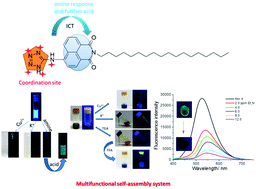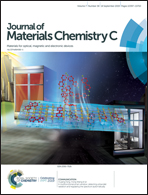Multifunctional fluorescent naphthalimide self-assembly system for the detection of Cu2+ and K+ and continuous sensing of organic amines and gaseous acids†
Abstract
A new fluorescent supramolecular self-assembly gelator (1) based on naphthalimide derivative with a tetrazole group was designed and synthesized, which could form a stable gel in acetone/H2O (1/1, v/v). The self-assembly process of gelator 1 was studied through SEM, UV-Vis absorption, fluorescence emission, XRD, and water contact angle. The microbelt structure was observed for the self-assembly system with its hydrophobic surface with the contacting angle of 143°. J-type aggregation mode was employed in the gel state, whose fluorescence emission showed a large red-shift of 153 nm compared with that for the solution state. This self-assembly system could selectively detect Cu2+ and K+, and their corresponding limit of detection was 5.65 × 10−7 M and 1.73 × 10−7 M, respectively. it's the fluorescence emission and color changed during the detection process of K+. This self-assembly was immune to acid although it has a tetrazole group. Interestingly, this self-assembly system could continuously respond to the organic amine and gaseous acid in three different states such as solution, gel, and xerogel. The limit of detection in the solution state for TEA and TFA was 7.66 × 10−5 M and 2.01 × 10−7 M, respectively. The limit of detection of the xerogel film towards TEA was 0.19 ppm. This research will provide a new way for the construction of multifunctional self-assembly systems for the detection of metal ions or organic amines and gaseous acids.



 Please wait while we load your content...
Please wait while we load your content...